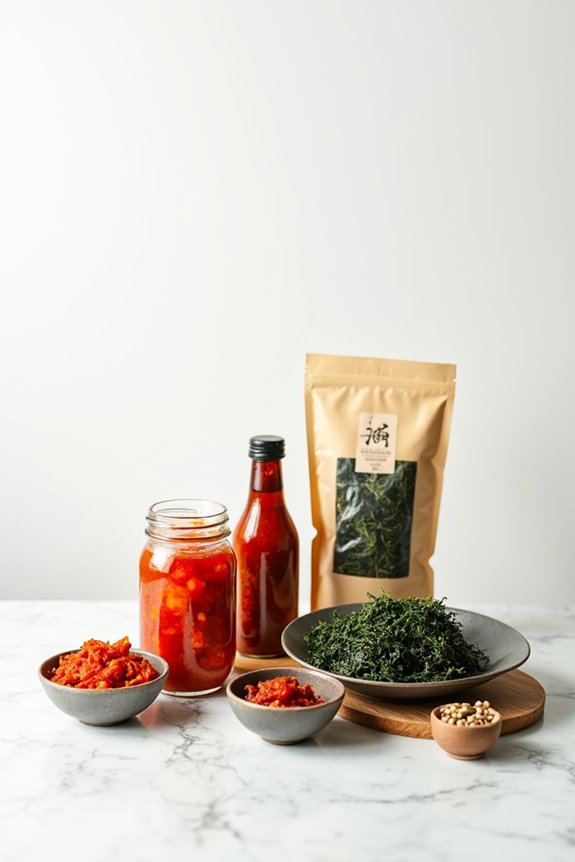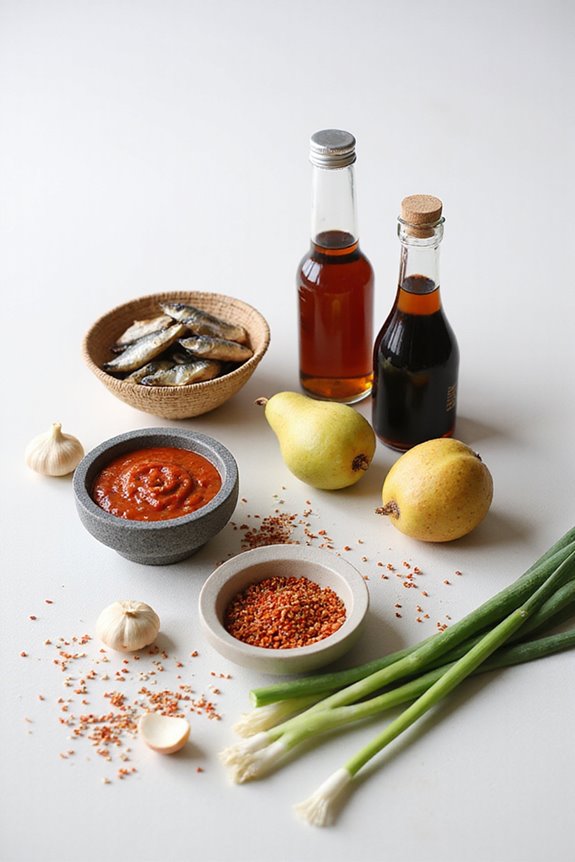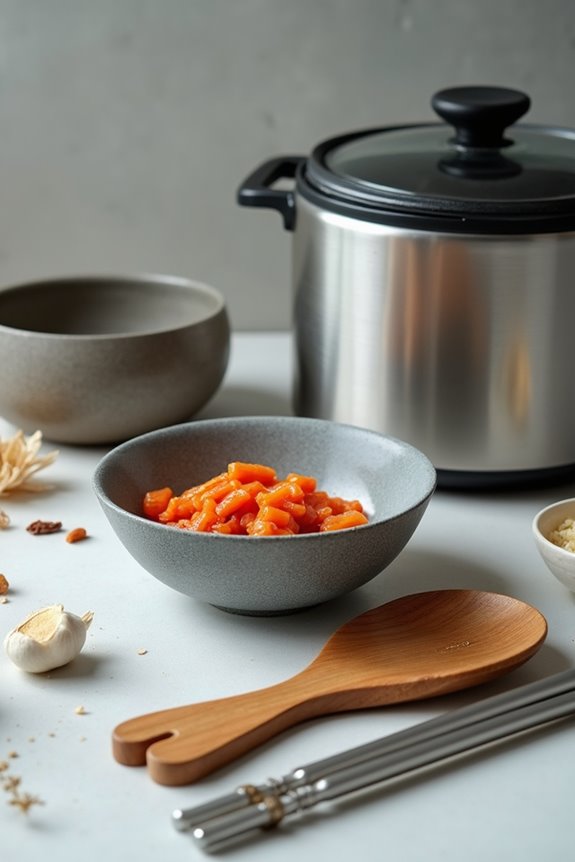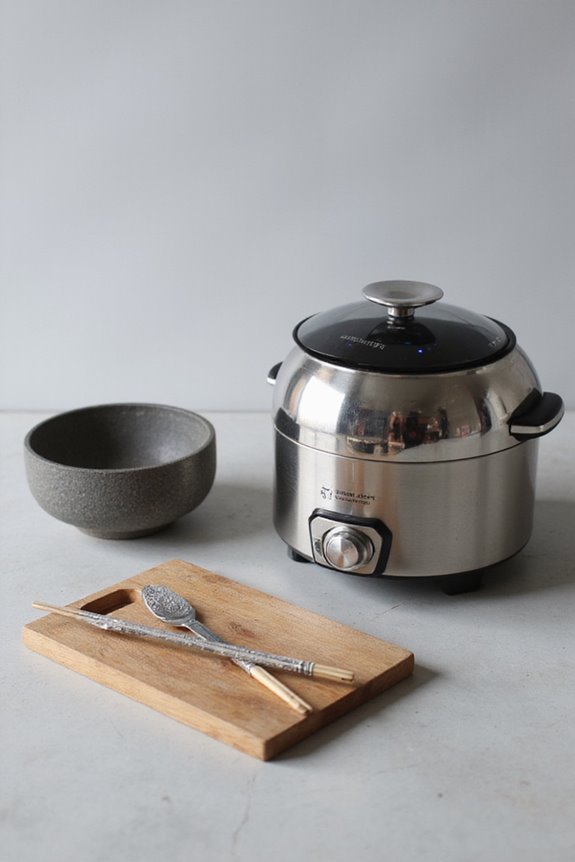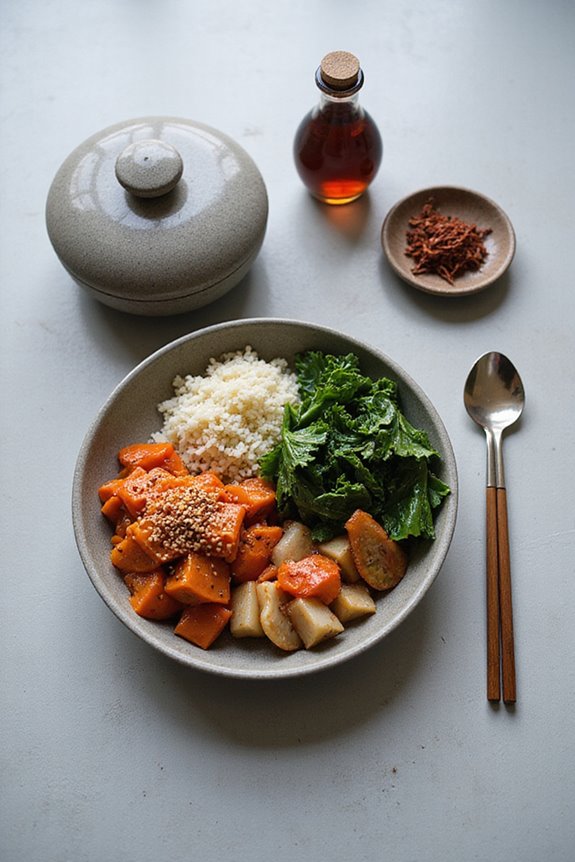Korean food products that promote health include fermented options like kimchi, which aids gut health with its probiotic content. We also benefit from vegetable-rich dishes, such as bibimbap, that enhance both flavor and nutrient intake. Lean protein sources, including boneless chicken and tofu, offer essential amino acids without excess fat. Whole grains, exemplified by multigrain rice dishes, provide crucial nutrients and fiber. As we explore more, we’ll uncover additional healthy trends in Korean cuisine.
Key Takeaways
- Fermented foods like kimchi and doenjang boost gut health with beneficial lactic acid bacteria and probiotic diversity.
- Bibimbap showcases a variety of fresh vegetables, providing essential vitamins and nutrients.
- Lean proteins such as boneless chicken thighs and tofu support balanced meals without excess fat.
- Japgokbap, a multigrain rice, offers complex carbohydrates and essential nutrients for digestive health.
- Modern adaptations of traditional dishes prioritize plant-based ingredients while maintaining authentic Korean flavors and nutrition.
Understanding Fermented Foods and Their Benefits
Fermented foods, such as those commonly found in Korean cuisine, offer a unique blend of flavors and health benefits that we can all appreciate. These dishes, including kimchi and doenjang, showcase the fermented benefits of using lactic acid bacteria like Lactobacilli, which are crucial for promoting gut health and immunity. The probiotic diversity found in these foods supports a balanced gut microbiome, essential for digestion and immune regulation. Regular consumption contributes to improved gut-lung immunity, potentially shielding us from respiratory infections. Additionally, the bioactive compounds present in these fermented products deliver antioxidative, anti-inflammatory, and antibacterial effects. By incorporating Korean fermented foods into our diets, we enhance our overall health and well-being, making them a valuable addition to our meals. Kimchi’s anaerobic conditions during fermentation further enhance its probiotic content and flavor profile.
The Role of Vegetables in Korean Cuisine
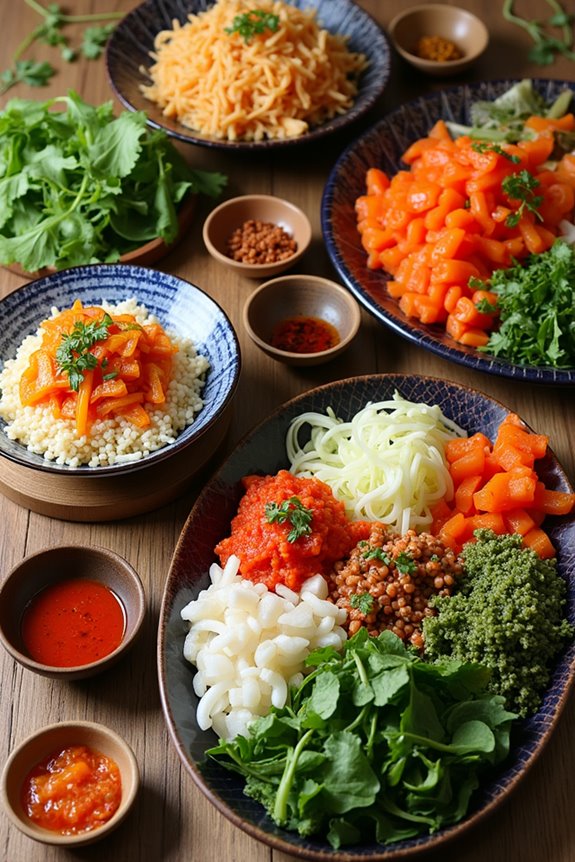
Korean cuisine is renowned for its vibrant array of vegetables, which play a fundamental role in both flavor and nutrition. With numerous vegetable varieties, including leafy greens, root vegetables, and wild mountain greens (sanchae), Korean dishes prioritize nutrient density. Typical meals often incorporate dishes like bibimbap and seasoned spinach, which showcase these fresh ingredients. The presence of banchan, primarily vegetable-based side dishes, guarantees a higher daily intake of vegetables compared to many Western diets. Minimal processing methods, such as blanching or steaming, help retain crucial nutrients like vitamins A, C, and K, essential for health. This emphasis on vegetables not only enhances meal palatability but also supports overall well-being through beneficial fiber, antioxidants, and phytonutrients.
Lean Protein Options in Korean Meals
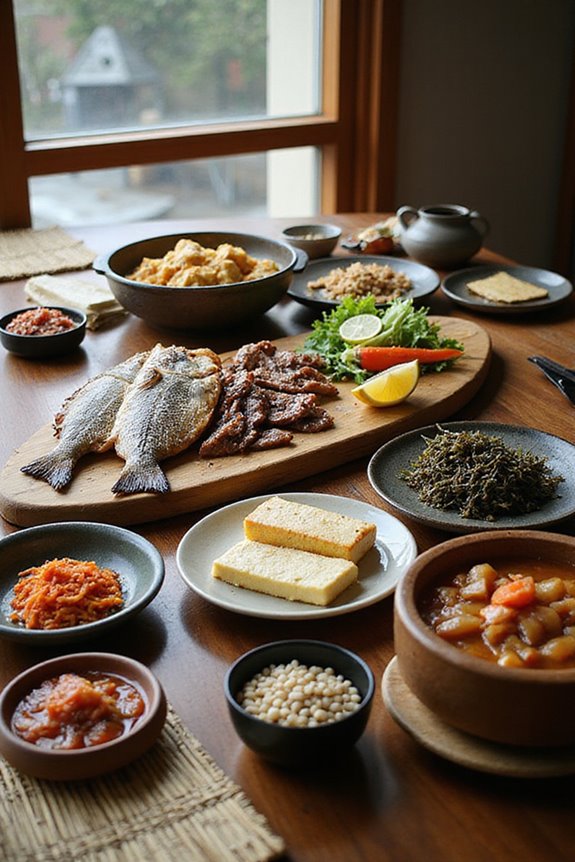
When considering meal options, lean protein sources are essential to maintaining balanced Korean diets, as they provide crucial nutrients without excessive fats. We often find boneless, skinless chicken thighs featured prominently, especially in dishes like dakdoritang, which offers around 31 grams of protein with lower fat. Additionally, shrimp is another excellent lean protein, highlighted in stir-fry bowls that include vitamin-rich vegetables. Tofu also plays a significant role, offering a plant-based protein option, particularly in soondubu jjigae. Furthermore, eggs are versatile, providing complete protein while enhancing various meals. Overall, incorporating these lean protein sources guarantees we enjoy healthy meals that are nutritious, satisfying, and lower in calories compared to traditional options like pork belly or red meats.
Whole Grains and Balanced Carbohydrate Sources
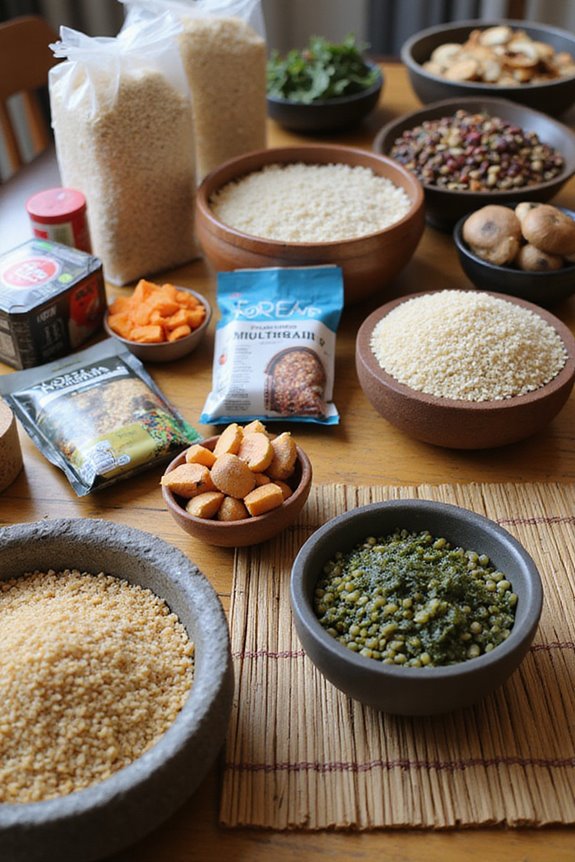
In our pursuit of balanced nutrition, whole grains play a foundational role in the Korean diet, serving as a primary source of complex carbohydrates. A notable example is japgokbap, a multigrain rice dish that combines brown rice, millet, and various legumes, providing numerous multigrain benefits. This dish not only enhances dietary diversity but also offers essential nutrients like B vitamins, iron, and fiber, supporting digestive health and overall wellness. It’s common for families to incorporate different grains based on personal preferences, fostering greater acceptance of whole grains in households. Despite these advantages, many Koreans still consume below the recommended levels of whole grains, emphasizing the need for enhanced public awareness and accessibility to promote healthier dietary choices.
Functional Ingredients and Superfoods
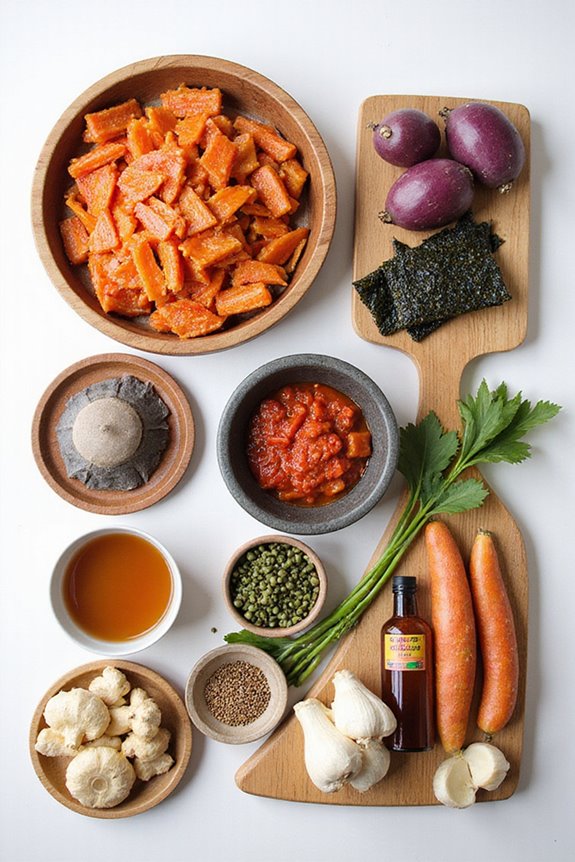
Among the various components of a nutritious diet, functional ingredients and superfoods play an essential role in enhancing health benefits and supporting overall wellness. Foods like ginger are celebrated for their ability to aid digestion and metabolism, while seaweed, rich in essential minerals and vitamins, offers numerous superfood benefits, particularly for postpartum recovery. Fermented soy products such as chongkukjang and doenjang contain immunomodulatory properties and probiotics that bolster gut health. Additionally, Korean chili paste, gochujang, illustrates how fermentation amplifies the potency of healthful compounds. Perilla leaves and various nutrient-dense greens contribute essential vitamins and antioxidants, collectively enriching our diets. By incorporating these functional ingredients, we can support our overall health effectively.
Navigating Nutrition Labels for Healthier Choices
How do we guarantee that we’re making the healthiest choices when managing nutrition labels on Korean food products? We must first assess serving sizes (제공량), as these indicate the amount relevant to stated nutrition values. Comparing serving sizes helps us avoid underestimating our nutrient and calorie intake. Next, we should examine calorie content (열량) and consider nutrient density, which balances calories with protein, healthy fats, and dietary fiber (식이섬유). We must be cautious of products that are low in calories but high in sugars or unhealthy fats, as these can be misleading. By focusing on nutrition labels that highlight beneficial nutrients while monitoring detrimental ones like sodium (나트륨) and trans fats (트랜스지방), we enhance our health choices effectively.
Modern Trends in Healthy Korean Eating
As we explore healthier options within Korean cuisine, it becomes evident that modern trends reflect a growing awareness of nutrition and wellness. One prominent trend is the rise of plant-based innovations, where traditional dishes like bibimbap are crafted using vegan ingredients that maintain flavor while appealing to ethical dietary choices. Additionally, fermented foods, such as kimchi, continue to thrive, featuring prominently in dishes and even influencing probiotic desserts, like yogurt-based sweets enriched with beneficial bacteria. These adaptations not only support gut health but also cater to consumers seeking nutrient-dense, flavorful meals. Moreover, the focus on fresh, seasonal produce enhances the overall quality of Korean dishes, showcasing the cuisine’s adaptability to contemporary health demands and preferences. Many health-conscious individuals are also incorporating authentic Korean flavors from seasoning sets into their meals to elevate taste without compromising on nutrition.
Frequently Asked Questions
Are There Gluten-Free Options in Traditional Korean Foods?
Yes, there are plenty of gluten-free options in traditional Korean foods. We can enjoy fermented options like kimchi and explore gluten alternatives such as glass noodles and rice cakes, ensuring a delicious and safe dining experience.
What Are the Best Cooking Methods for Preserving Nutrients in Korean Dishes?
When it comes to preserving nutrients in Korean dishes, we find steaming vegetables and fermenting foods particularly effective. These methods enhance flavor and retain essential nutrients, making our meals both healthy and delicious.
How Do Portion Sizes in Korean Meals Typically Compare Internationally?
When we savor a delicious Korean meal, we notice how portion sizes emphasize meal balance and portion control. For instance, enjoying bulgogi with multiple banchan means we’re nourished without overwhelming our plates or ourselves.
Are There Any Specific Allergies to Consider With Korean Ingredients?
When exploring Korean ingredients, we should definitely consider possible allergy considerations. Common allergens like seafood, soy, and tree nuts often appear in traditional dishes, so it’s important for us to stay aware of sensitivities.
How Can I Make Traditional Korean Dishes Lower in Sodium?
To lower sodium in traditional Korean dishes, we can use sodium alternatives while focusing on flavor enhancement. Incorporating fresh herbs, vinegar, and reducing high-sodium ingredients can make our meals deliciously healthier without sacrificing taste.

